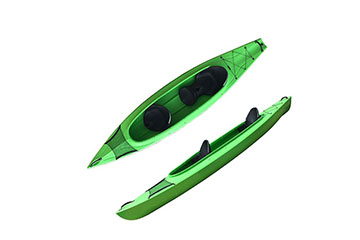The Main Difference Between Canoeing And Kayaking
The Main Difference Between Canoeing And Kayaking
1. speed
In the field of water sports, canoes are called "pickup trucks". Due to the size and extra weight, multiple passengers riding at the same time will hinder the speed of the canoe.
On the other hand, kayaks are considered a kind of "sports car". Kayaks are faster than canoes and hence are more exciting in water sports competitions. Kayaks are light in weight, usually carry a small number of passengers (mostly only one passenger), and have a low profile shape, all of which make them faster in the water.
Canoe vs kayak:
The canoe is big, heavy, and slow
Kayak is lighter and faster
2. Ship design
The hull of the canoe is open and can accommodate multiple passengers at the same time. The design of the canoe is very suitable for calm waters, and the open concept allows passengers to move freely in the boat. However, riding a canoe in rough water may cause a large amount of water to enter and be collected at the bottom of the boat.
The kayak has an enclosed deck, usually with a spray skirt (where the passengers' seat). Passengers huddled together from all sides (except the top), making it impossible to move freely on the ship. However, the enclosed deck ensures minimal water collection on the boat, even in rough water, making the kayak more suitable for challenging water conditions.
Although all canoes are similar in size and design, there are many types of kayaks for different purposes, and each type of kayak has a different hull design, depending on the specific activity. These include:
Single Kayak-a recreational kayak for single riders (most common)
Double kayaks-also known as tandem kayaks, these boats are designed to accommodate two passengers.
White water kayak-as the name suggests, white water kayak is designed to meet the strict and maneuverability requirements of the rushing river (also known as white water kayak).
Sea kayaks-Sea kayaks (sometimes called touring kayaks) are narrower and longer than regular kayaks. Its maneuverability is poor, but it will get a higher speed when cruising. Sea kayaking usually paddles long distances.
Fishing kayak-for fishing is usually a wider kayak, which provides a more stable platform for anglers, while kayak fishing.
An inflatable kayak-the inflatable kayak is just like its name. They are good for occasional kayaks and take up less storage space than standard kayaks when deflated.
Canoe or kayak:
A recreational canoe can accommodate multiple passengers, is designed for calm waters, and is more stable.
A standard kayak usually has only one passenger, and depending on the design and activity, it can handle rough or calm waters.
3. Paddle
The paddles of the canoe only have paddles on one side of the pole. The single oar paddle is perfect because the passenger sits slightly higher, making it more comfortable for the rider to use the single oar paddle. A paddle perfectly integrates the technology of propelling the canoe.
On the other hand, kayaks have paddle blades at both ends of the paddle pole. This is because the passengers on the kayaks sit lower than the canoes. A canoe rider cannot move as freely, so it is very convenient to use two oars to propel the kayak forward. In this regard, riding a kayak can become difficult because it requires a lot of energy and endurance, but it is very easy to learn to use two paddles.
If you want to know, why don't we just use the kayak paddle in the canoe? A canoe is much wider than a kayak. So using a twin-blade paddle is useless, because you can't use the kayak paddling technique to paddle a canoe.

Kayak










